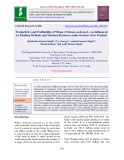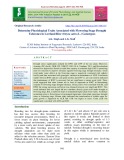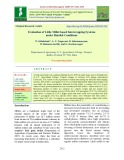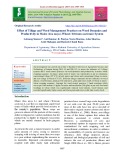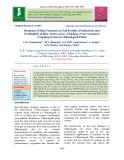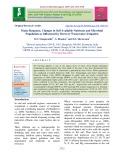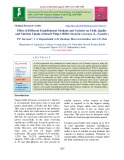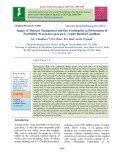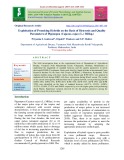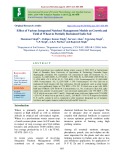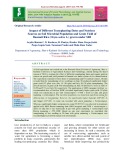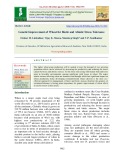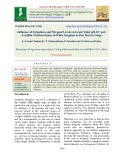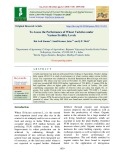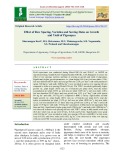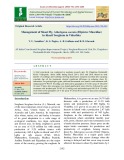
Significantly higher grain
-
A field experiment conducted during 2014-15 and 2015-16 at Crop Research Farm, Department of Agronomy, Naini Agricultural Institute, SHUATS, Prayagraj (U.P.); to evaluate the productivity and profitability of wheat as influenced by planting methods and nutrient resources eastern Uttar Pradesh. Data revealed that planting methods; system of wheat intensification (SWI) found significantly higher plant height, plant dry weight, leaf area index, grains/spike, 1000-grain weight, grain yield, straw yield and economics of wheat over to FIRBS and conventional method of planting.
 11p
11p  trinhthamhodang11
trinhthamhodang11
 27-04-2021
27-04-2021
 11
11
 2
2
 Download
Download
-
A field experiment was conducted during Kharif season of 2018 in Alfisols to study grain yield of hybrid rice varieties as influenced integrated nutrient management. Results revealed that V1 (IRH-103) found significantly highest N, P and K contain in grain and straw of than V2 (IRH-111) and in different nutrient management N5 (150% RDF through inorganic) was observed significantly higher N, P and K contain in grain and straw.
 9p
9p  chauchaungayxua10
chauchaungayxua10
 19-03-2021
19-03-2021
 18
18
 2
2
 Download
Download
-
Present study indicated that translocation of soluble sugar for grain growth is supported by ACR and ATR was higher in stress. Grain yield was significantly correlated with ACR and ATR.
 11p
11p  trinhthamhodang1215
trinhthamhodang1215
 23-09-2020
23-09-2020
 12
12
 1
1
 Download
Download
-
A field experiment was conducted during kharif, 2019 on sandy loam soils of dryland farm of S.V. Agricultural College, Tirupati campus of Acharya N.G. Ranga Agricultural University. The results of the experiment revealed that among the different intercropping systems, little millet + greengram (4:2) (T6) recorded significantly higher plant height, leaf area index, dry matter production followed by little millet + cowpea (4:2) (T7). Lower values of these growth parameters were recorded with little millet + cluster bean (4:2) (T8).
 4p
4p  kethamoi7
kethamoi7
 26-08-2020
26-08-2020
 8
8
 2
2
 Download
Download
-
A field experiment was conducted in sandy clay loam soil of S.V. Agricultural College Farm, Tirupati with three levels of nitrogen viz., 75, 100, 125 % RDN and five biofertilizers viz., Azospirillum, phosphorus solubilizing bacteria (PSB), potassium solubilizing bacteria (KSB), zinc solubilizing bacteria (ZnS) and combined application of Azospirillum + PSB + KSB + ZnS each applied @ 5 kg ha-1 in randomized block design with factorial conceptin kharif maize.
 5p
5p  kethamoi7
kethamoi7
 26-08-2020
26-08-2020
 21
21
 2
2
 Download
Download
-
Evaluation of new different fungicides, using the susceptible maize genotype CM-202 for the management of turcicum leaf blight caused by Exserohilum turcicum revealed that the combi products Azoxystrobin 18.2% + Difenoconazole 11.4% SC @ 0.250 ml /liter was found more effective in reducing the severity of disease followed by Azoxystrobin 18.2% + Difenoconazole 11.4%) SC @ 0.125 ml /liter were found effective in reducing the disease severity and also contributed for higher grain yield and The treatment which received a foliar spray of systemic fungicide Tebuconazole 250 EC @ 1.
 5p
5p  angicungduoc6
angicungduoc6
 22-07-2020
22-07-2020
 9
9
 1
1
 Download
Download
-
An investigation was carried out at Sher-e-Kashmir University of Agriculture Science and Technology of Jammu during 2013-14 and 2014-15, to assess the influence of 4 tillage systems and 3 weed-control practices on weed dynamics and productivity in maize-wheat cropping sequence. In maize, grain yield of maize was statistically at par in continuous conventional tillage (CT-CT) in both maize and wheat and conventional tillage in maize and zero tillage in wheat (CT-ZT).
 7p
7p  angicungduoc6
angicungduoc6
 20-07-2020
20-07-2020
 18
18
 1
1
 Download
Download
-
A field experiment was conducted to study the on farm crop response to plant nutrients in pre dominant cropping system i.e. rice, (Oryza sativa) - chickpea (Cicer arietinum) and their impact on productivity, soil fertility and economics at Kabirdham district of Chhattisgarh state during 2013-14 and 2014-15. The results revealed that application of 100 kg N, 60 kg P2O5, 40 kg K2O and 20 kg ZnSO4 /ha to rice and 20 kg N, 50 kg P2O5, 20 kg K2O /ha to chickpea recorded significantly higher grain and straw/ haulm yields. Rice equivalent yield (87.
 9p
9p  angicungduoc6
angicungduoc6
 20-07-2020
20-07-2020
 11
11
 1
1
 Download
Download
-
The brewing industry is one of the largest users of water. Even though substantial technological improvements have been made in the past, it has been documented that approximately 3 to 10 litres of wastewater is generated per litre of beer. Field experiments was conducted at United Breweries (UB) Ltd., Nelamangala and Zonal Agricultural Research Station, UAS, GKVK, Bengaluru in sandy loam soil results revealed that application of 150% RDN through TBWW as 50% basal and 50% in three irrigations recorded significantly higher grain yield (39.6 q ha-1 ) and stover yield (69.
 9p
9p  angicungduoc6
angicungduoc6
 20-07-2020
20-07-2020
 15
15
 2
2
 Download
Download
-
A field experiment was conducted on coastal lateritic soil of Konkan region to study the effect of different establishment methods and varieties on yield, quality and nutrient uptake of Kharif finger millet [Eleusine coracana (L.) gaertn.] during kharif 2014 at Agronomy Farm, College of Agriculture, Dapoli. The experiment was laid out in strip plot design with three replications. Result revealed that transplanting method recorded significantly higher grain (23.58 q ha-1 ) and straw (33.
 5p
5p  trinhthamhodang6
trinhthamhodang6
 09-07-2020
09-07-2020
 18
18
 2
2
 Download
Download
-
The present study was conducted during kharif, 2012 and 2013 at ICAR-Indian Agricultural Research Institute, New Delhi to find out the effect of moisture management and zinc fertilization on performance of pearlmillet under rainfed conditions. Results of two year study showed considerable improvement in growth and productivity of pearlmillet. Flat bed with 5.0 t/ha crop residue recorded significantly higher plant height, dry matter accumulation, number of earheads, grain weight per earhead, yield and profitability as compared to flat bed without crop residue and flat bed with 2.
 10p
10p  trinhthamhodang6
trinhthamhodang6
 09-07-2020
09-07-2020
 14
14
 2
2
 Download
Download
-
An experiment was conducted in cemented pot in “screen house” of the Department of Soil Science and Agricultural Chemistry, Chandra Shekhar Azad University of Agriculture and Technology, Kanpur during Rabi season 2011-2012, to assess the response of inoculation of rhizobium and application of different doses of iron on nutrient uptake in chickpea. Treatments consisted four levels of iron i.e. 0, 2.5, 5.0 and 7.5 ppm and two levels of microbial inoculation i.e. un-inoculation and inoculation of rhizobium. The treatments were replicated four times in completely randomized design (factorial).
 7p
7p  chauchaungayxua6
chauchaungayxua6
 26-06-2020
26-06-2020
 21
21
 1
1
 Download
Download
-
The field investigation done at the experimental farm of Department of Agricultural Botany, Vasantrao Naik Marathwada Krishi Vidyapeeth, Parbhani, Maharashtra to understand the magnitude of standard heterosis and dal quality parameters in newly developed CGMS (Cytoplasmic Genic male Sterility) based hybrids at International Crops Research Institute for the Semi-Arid Tropics (ICRISAT), Patancheru, Hyderabad. Total eighteen hybrids along with three checks (Asha, Maruti and ICPH 2671) were planted in randomized block design (RBD) with three replications during Kharif season.
 9p
9p  chauchaungayxua6
chauchaungayxua6
 26-06-2020
26-06-2020
 17
17
 0
0
 Download
Download
-
A field experiment was conducted during winter season of 2011-2012 at Instructional Farm of Narendra Deva University of Agriculture & Technology Narendra Nagar (Kumarganj), Faizabad. The experiment was consisting of eight (8) treatment viz., T1 (control), T2 (100% RDF), T3 (75% RDF + 25% FYM-N), T4 (50% RDF +50% FYM- N), T5 (25% RDF +75 % FYM -N), T6 (75% RDF + 25% Vermicompost-N), T7 (50% RDF +50% Vermicompost -N), T8 (25% RDF + 75% Vermicompost -N) were laid out in randomized block design with four replication.
 6p
6p  chauchaungayxua6
chauchaungayxua6
 26-06-2020
26-06-2020
 17
17
 0
0
 Download
Download
-
A field experiment was carried out at the Research Farm, Division of Agronomy, Sher-eKashmir University of Agricultural Sciences and Technology, Jammu during the kharif season of 2014 to evaluate the effect of different transplanting dates and organic nutrient sources on growth and yield potential of basmati rice under system of rice intensification. The experiment consisted of three dates of transplanting and five nutrient sources.
 5p
5p  chauchaungayxua6
chauchaungayxua6
 26-06-2020
26-06-2020
 11
11
 0
0
 Download
Download
-
The higher wheat grain production will be needed to meet the demand of ever growing population which can be achieved by increasing the productivity and reducing the losses caused by biotic and abiotic stresses. All the three rusts along with Karnal bunt and loose smut in favorable environments causing significant yield losses in wheat.
 10p
10p  quenchua6
quenchua6
 15-06-2020
15-06-2020
 12
12
 1
1
 Download
Download
-
Field experiment was conducted at Regional Agricultural Research Station, Nandyal during post rainy season (maghi), 2015-16 to study the response of white sorghum to irrigations and nitrogen levels. The results of the experiment revealed that the available nitrogen status was higher with the application of 180 kg N ha-1 than 150, 120 and 90 kg N ha-1 and available phosphorus and available potassium were higher with application of 90 kg N ha-1 than other nitrogen levels. In case of irrigations, no irrigation recorded higher available nutrients than two irrigations and one irrigation.
 7p
7p  gaocaolon5
gaocaolon5
 14-06-2020
14-06-2020
 8
8
 1
1
 Download
Download
-
A field experiment was laid out at Research Farm, College of Agriculture, Gwalior, during Rabi season (2014-15) to study of performance of wheat varieties under various fertility levels. The experiment was conducted in Factorial Randomized Block Design with three replications. The wheat crop was sown on November 21, 2014. Significant higher grain yield was recorded MP 4010 (4520 kg/ha). Application of 75% RDF + 5 tonnes FYM /ha had significant effect on higher grain yield than other levels of fertility...
 8p
8p  angicungduoc5
angicungduoc5
 12-06-2020
12-06-2020
 10
10
 1
1
 Download
Download
-
Field experiment was conducted during Kharif-2015-16 and 2016-17 at AICRP on Agrometeorology, Gandhi Krishi Vignana Kendra (GKVK), UAS, Bangalore to assess the effect of row spacing, varieties and date of sowing on growth and yield of pigeonpea. Significantly higher growth parameters viz., plant height (165.4 cm), leaf area index (2.10), leaf area duration (60.34 days) and crop growth rate (2.39 g m-2 day-1 ) and yield parameters (grain: 940 kg ha-1 and stalk: 4089 kg ha-1 ) were recorded in narrow row spacing (60 cm) compared to wider row spacing (90 and 120 cm).
 6p
6p  cothumenhmong5
cothumenhmong5
 17-05-2020
17-05-2020
 17
17
 1
1
 Download
Download
-
A field experiment was conducted at sorghum research unit, Dr. Panjabrao Deshmukh Krishi Vidyapeeth, Akola (MH) during kharif 2014, 2015 and 2016. Based on total number of seedlings and seedlings showing dead hearts symptom recorded after spraying conclude that all the treatments showed significant difference in reducing shoot fly infestation.
 15p
15p  chauchaungayxua5
chauchaungayxua5
 08-05-2020
08-05-2020
 11
11
 0
0
 Download
Download
CHỦ ĐỀ BẠN MUỐN TÌM









